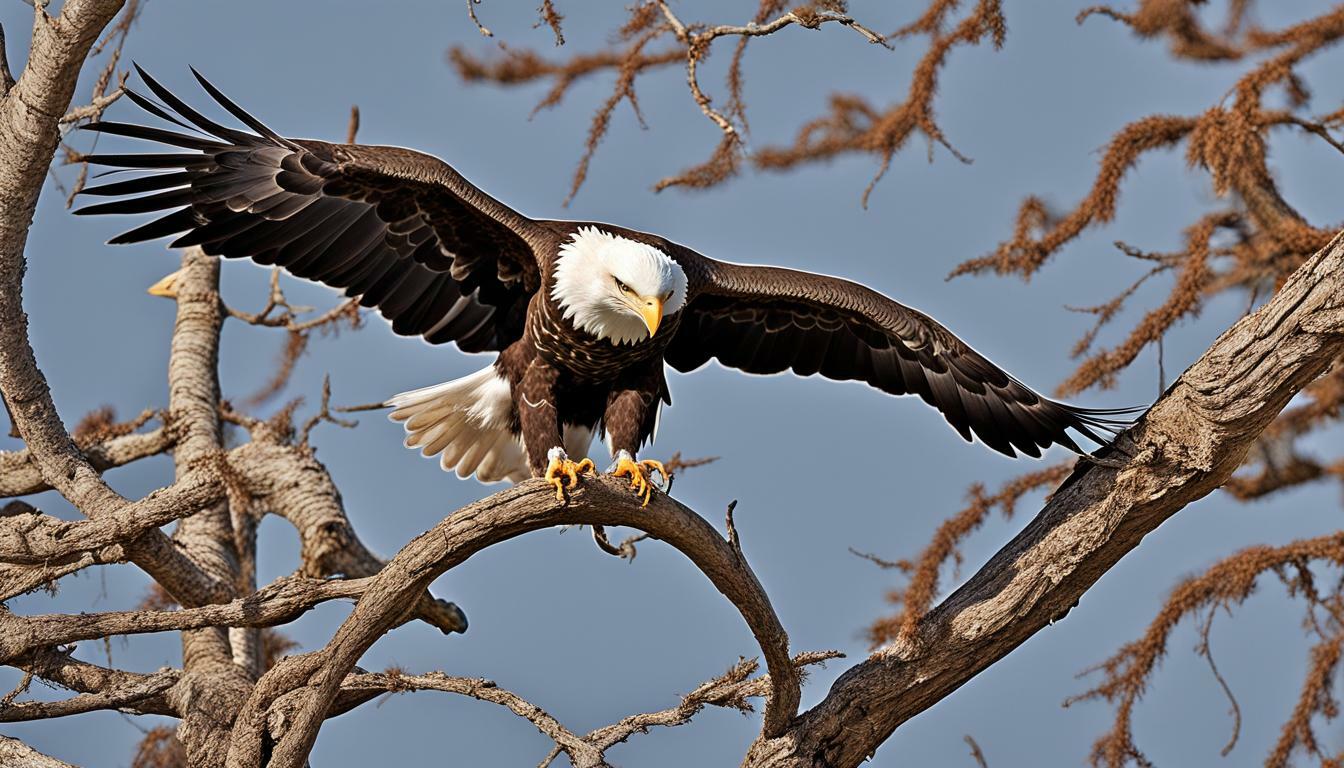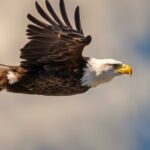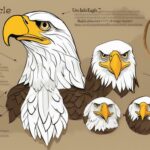Have you ever wondered if a bald eagle, with its impressive wingspan and powerful talons, could break your arm? It’s not an unreasonable question, particularly if you enjoy bird watching or have a fascination with these magnificent creatures. Understanding the potential risks when interacting with bald eagles is important, not only for your own safety but also for the conservation of this protected species.
Key Takeaways:
- The physical abilities of a bald eagle, such as sharp talons and a powerful beak, can pose a risk to humans.
- While injuries from bald eagle encounters can be serious, they are rarely sufficient to break a human arm.
- Respecting their space and observing from a safe distance is the best way to prevent injuries.
- Education and awareness are crucial to promoting responsible interactions with wildlife.
Understanding Bald Eagle Behavior
If you’re concerned about the potential risks of interacting with bald eagles, it’s important to understand their behavior. While eagles are known for their powerful talons and beaks, they are rarely a threat to humans.
Bald eagles have a natural fear of humans and will generally avoid confrontation if possible. However, if they feel threatened or provoked, they may defend themselves with their sharp talons and beaks.
Bald Eagle Predatory Instincts
As predators, bald eagles have a strong hunting instinct that makes them efficient killers. They have excellent eyesight and can spot potential prey from great distances. When they spot a target, eagles will swoop down and grab it with their talons before carrying it away to a safe spot to eat.
While it’s rare for bald eagles to attack humans, they have been known to go after small dogs, cats, and other small animals. If you’re in an area where eagles are known to live, it’s important to keep your pets on a leash and to supervise them closely.
Protective Nature of Bald Eagles
While bald eagles may seem intimidating, they are protective creatures when it comes to their young. Eagles will fiercely defend their nests and young, and may attack if they feel like their offspring are in danger.
If you come across a bald eagle nest, it’s important to keep your distance. Avoid getting too close to the nest or making loud noises that could disturb the birds.
By understanding bald eagle behavior, you can take the necessary precautions to avoid injury and ensure a safe and enjoyable experience observing these majestic creatures.
Bald Eagle Physical Capabilities
When it comes to the physical capabilities of bald eagles, it’s important to understand the potential dangers they pose to humans. With razor-sharp talons and powerful beaks, these majestic birds are formidable predators. They also possess incredible strength, with the ability to carry prey that outweighs them.
Despite their impressive size and power, bald eagles generally avoid confrontation with humans. However, if they feel threatened or perceive a potential attack on their young, they may become aggressive.
It’s crucial to maintain a safe distance from these birds to prevent injury. Even a small scratch or puncture wound from a bald eagle’s talons or beak can lead to infection and other complications.
Fortunately, the likelihood of a bald eagle breaking a human’s arm is very low. While their talons are certainly strong and sharp, they may not be sufficient to cause a bone-breaking injury. However, it’s still important to take precautions to avoid any type of injury when interacting with these birds.
Potential Arm Injuries from Bald Eagles
While bald eagles are generally non-aggressive towards humans, there is still a potential for injury when interacting with these birds. The sharp talons on their feet and powerful beaks can cause scratches, cuts, and puncture wounds.
These injuries can be serious, but they are rarely sufficient to break a human’s arm. However, it is important to take precautions and maintain a safe distance to prevent any potential injuries.
If you do happen to sustain an injury from a bald eagle, seek medical attention immediately. Treat the wound as soon as possible to prevent infection and further damage.
Precautions and Safety Measures
When it comes to interacting with bald eagles, safety should always be your top priority. These birds are powerful predators, and while they rarely attack humans, it’s important to take precautions to prevent arm injuries or other harm. Here are some practical tips to keep in mind:
- Avoid getting too close: Bald eagles have sharp talons and powerful beaks that can cause serious injury. Maintain a safe distance of at least 330 feet (100 meters) from the birds to reduce your risk of harm.
- Observe from afar: Use binoculars or telephoto lenses to get a closer look without approaching the birds. This is a safe and effective way to appreciate their beauty without risking injury.
- Don’t attempt to touch or feed eagles: Bald eagles are wild animals and should never be approached or fed. This can lead to dangerous situations and may harm the birds by disrupting their natural behaviors or diet.
- Pay attention to eagle behavior: If you notice an eagle acting aggressively or erratically, stay away. This could be a sign of stress or distress, which can lead to attacks or other risky behaviors.
- Protect your pets: Keep your pets on a leash or indoors when bald eagles are present. Small dogs and cats can be seen as prey by these birds, so it’s important to take extra precautions to ensure their safety.
Remember, bald eagles are a vital part of our ecosystem and should be respected and admired from a safe distance. By taking the necessary steps to ensure your own safety and the safety of these birds, we can all coexist harmoniously in the natural world.
Understanding Bald Eagle Conservation
Bald eagles are a symbol of American strength and freedom, but they were once on the verge of extinction. Due to habitat loss, hunting, and pollution, their population declined to just a few hundred pairs in the 20th century. Fortunately, conservation efforts have been successful in restoring the population to healthy levels.
In 1963, the Bald Eagle Protection Act was passed, which prohibits killing or disturbing bald eagles, their nests, or eggs. This was followed by the Endangered Species Act of 1973, which listed bald eagles as endangered. The bird was delisted in 2007 due to the successful population recovery efforts.
Despite their protected status, it is important to understand that bald eagles still face threats, such as habitat loss and human disturbance. Conserving their habitat and promoting responsible interactions with these birds is critical to their continued success.
Human-Bald Eagle Interactions
When it comes to interacting with bald eagles, it’s important to maintain a safe and respectful distance. While it may be tempting to get up close for a better view or photo, it’s not worth risking injury to yourself or the bird.
Whether you’re bird watching or photographing wildlife, it’s important to observe from a distance and avoid any behavior that could be perceived as a threat. Bald eagles are generally not aggressive towards humans, but they may become defensive if they feel threatened or provoked.
Keep in mind that disturbing or harming bald eagles is not only unsafe but also illegal under the Bald and Golden Eagle Protection Act. If you witness any aggressive or unusual behavior from a bald eagle, it’s important to document and report it to the relevant authorities or organizations.
By respecting these majestic birds and their natural habitat, we can coexist and appreciate their beauty from a safe distance. Remember to always take the necessary precautions and enjoy the wonder of bald eagles without risking harm or disturbance to them or their habitat.
Potential Arm Injuries from Bald Eagles
While it is unlikely that a bald eagle could break your arm, it is important to be aware of the potential injuries that could result from an encounter with these birds.
The razor-sharp talons and powerful beaks of bald eagles can cause scratches, cuts, and puncture wounds. These injuries can be serious and may require medical attention. However, they are rarely sufficient to break a human arm.
If you are in close proximity to a bald eagle, it is essential to maintain a safe distance and avoid provoking or threatening the bird. Do not attempt to touch or hand-feed eagles, as this can result in aggressive behavior.
Education and Awareness
Now that you understand the potential dangers of interacting with bald eagles, it’s important to spread awareness and education about their behavior. By learning more about these magnificent creatures, you can appreciate them from a safe distance and avoid arm injuries.
One way to educate yourself is by attending bird-watching tours or wildlife photography classes. These events often include expert guides who can provide valuable information about bald eagles and their behavior.
You can also spread awareness by sharing your knowledge with others. Talk to friends and family about the importance of respecting bald eagles and keeping a safe distance. Encourage others to use binoculars or telephoto lenses to observe these birds up close.
If you’re a teacher or educator, consider incorporating bald eagle education into your curriculum. Teach students about the importance of wildlife conservation and how to safely observe birds in the wild.
By spreading education and awareness, we can all do our part to ensure the safety and conservation of these majestic birds.
Endeavoring to Coexist
Living harmoniously with wildlife, including bald eagles, is possible with a respectful and responsible approach. Appreciating these birds from a safe distance allows them to thrive in their natural habitat while avoiding potential dangers for humans. By following some simple guidelines, you can enjoy the beauty of these magnificent creatures while preventing arm injuries and supporting their conservation.
Here are some tips for coexisting with bald eagles:
- Observe from a safe distance: Keep at least 100 yards away from bald eagles in the wild. For bird watching or photography, consider using binoculars or a telephoto lens for a closer look.
- Respect their space: Avoid disturbing bald eagles during nesting season or when they are feeding. Stay away from nests and roosts to prevent aggressive behavior.
- Don’t feed or touch eagles: Hand-feeding or attempting to touch bald eagles can result in injury to both the bird and the human.
- Be aware of legal consequences: Bald eagles are protected under federal law, and disturbing or harming them can result in significant fines and legal consequences.
By following these simple guidelines, you can help ensure the continued success of bald eagle conservation efforts, while safely enjoying their majestic presence in the wild.
Conclusion
Now that you’ve learned more about bald eagles and their potential risks, it’s important to remember to always respect these majestic birds. While it’s highly unlikely that a bald eagle would break your arm, it’s still crucial to maintain a safe distance and avoid provoking them in any way.
By understanding bald eagle behavior, physical capabilities, and potential injuries, you can take precautions to minimize risks and prevent harm. Remember to use binoculars or telephoto lenses if you want to observe them closely.
Furthermore, it’s crucial to the conservation of bald eagles that we endeavor to coexist with these magnificent creatures peacefully. This means reporting incidents and spreading awareness about their behavior and conservation efforts.
Take the time to appreciate the beauty of bald eagles from a safe distance while respecting their habitat. By doing so, we can ensure that they continue to thrive in the wild for generations to come.
Do Bald Eagles Have the Ability to Rotate Their Heads 360 Degrees?
Do bald eagles have 360-degree head movement? Yes, they do! With their amazing neck flexibility, bald eagles can rotate their heads a full 360 degrees. This exceptional ability allows them to scan their surroundings, locate prey, and keep a watchful eye on their territory. The flexibility of their neck joints is crucial for their predatory success and survival in the wild.
FAQ
Q: Can a bald eagle break your arm?
A: No, it is highly unlikely for a bald eagle to break a human’s arm. While they have sharp talons and powerful beaks, bald eagle attacks on humans are extremely rare.
Q: What are the potential dangers of interacting with bald eagles?
A: The main potential danger is provoking or threatening the eagle, which might lead to aggressive behavior. It is important to maintain a safe distance and respect their space.
Q: What physical capabilities do bald eagles have that pose a risk to humans?
A: Bald eagles have razor-sharp talons and powerful beaks, which they use for hunting and defending themselves. It is crucial to avoid getting too close to them to prevent injuries.
Q: What are the potential arm injuries from bald eagles?
A: While scratches, cuts, and puncture wounds can occur from a bald eagle encounter, these injuries are rarely severe enough to break a human arm.
Q: What precautions should I take around bald eagles?
A: Respecting their space, observing from a safe distance, and refraining from attempting to touch or feed them are essential safety measures. Using binoculars or telephoto lenses is recommended for a closer look.
Q: Why is bald eagle conservation important?
A: Bald eagle conservation is crucial to protect these magnificent birds and ensure their continued recovery from near extinction. They are protected under the Bald and Golden Eagle Protection Act.
Q: How should I interact with bald eagles and other wild birds?
A: It is important to maintain a safe and respectful distance when observing or photographing bald eagles and other wild birds. Disturbing or harming protected birds can have legal consequences.
Q: How do I report bald eagle incidents?
A: If you witness an incident involving bald eagles, particularly if it results in injuries, report it to the relevant authorities or organizations. Documenting and reporting aggressive or unusual behavior is important for understanding and protecting these birds.
Q: Why is education and awareness about bald eagles important?
A: Educating the public about bald eagles, their behavior, and potential dangers promotes responsible interactions and helps protect these birds. Awareness campaigns and educational programs play a significant role in achieving this.
Q: How can we coexist with bald eagles?
A: Coexistence involves appreciating bald eagles from a safe distance while allowing them to thrive in their natural habitat. A respectful and responsible approach to wildlife enjoyment helps maintain a harmonious relationship.










